
|

In order to identify the effect of light level on accidents, the hour between 6 and 7 p.m. in March and September is called "dusky 6-7 p.m." as shown in Figure 6.
For comparison, the same hour in June and July is called "light 6-7 p.m.", and that of January, November and December, "dark 6-7 p.m." This makes it possible to exclude the influence of people”Ēs movement patterns determined by time. Analyses, however, are confined to accidents that took place on clear days to eliminate weather factors.
|
|
|
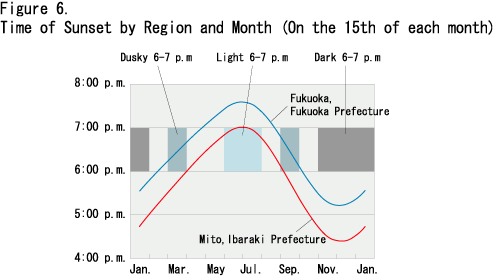
|
|
The following paragraphs discuss the effect of light level on pedestrian behavior in line with this concept.
All pedestrians involved in traffic accidents are analyzed, including not only those who were killed, but also those seriously injured, slightly injured, and not injured, for the following reason. The factor of human body resistance, which strongly affects whether a pedestrian involved in an accident survives or dies (primarily, the pedestrian's age),
is to be eliminated as much as possible.
a. Age of Pedestrians Prone to Accidents
Figure 7 compares the number of pedestrians involved in traffic accidents by level of light and by age group. Percentages of seniors aged 65 and above differ little between "dusky 6-7 p.m." and "dark 6-7 p.m.", suggesting that senior pedestrians behave in the dusk as they do in the nighttime. The component ratio of pedestrians aged 75 and above is highest in the dusk, although the difference is small.
|
|
|
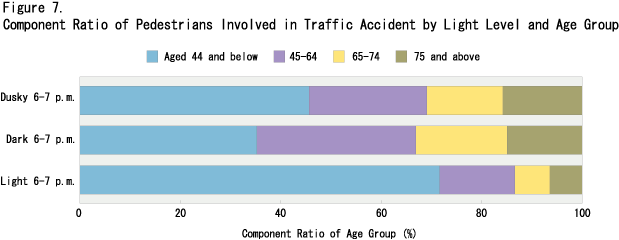
|
|
Figure 8 shows the fatality rate of pedestrians involved in traffic accidents (rate of deaths among those involved in accidents). The rate increases with age, with the rate being ten times higher among those aged 75 and above compared with those aged 44 and below.
|
|
|
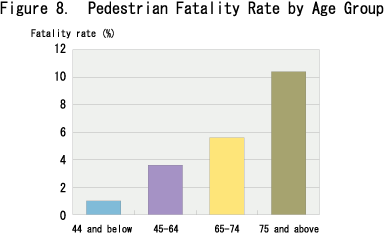
|
|
Clearly, one major factor for the increase in pedestrian accident fatalities in the dusk and later hours is the rise in accidents of senior pedestrians, who are killed at a much higher rate than younger people.
b. From Which Side Pedestrians Crossed
Among accidents in which a car, driving straight ahead, hits a pedestrian trying to cross a road, the fatality rate is compared in Figure 9, focusing on whether the pedestrian started to cross from the left or right side of the driver.
As shown, pedestrians crossing from the right side of drivers suffer a higher fatality rate.
|
|
|
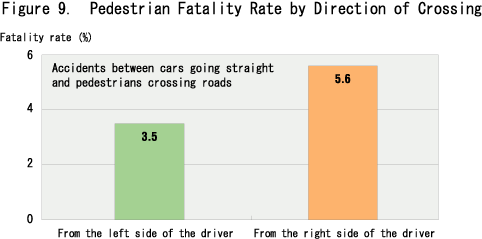
|
|
Figure 10 represents the percentage of pedestrians crossing from the right side of drivers among those who were involved in an accident while crossing the road, shown by age group and light level.
The rate of crossing-from-the-right pedestrians is 40% to 50% during "light 6-7 p.m." regardless of age, but the percentage tends to rise with age during "dusky 6-7 p.m." and "dark 6-7 p.m." Among seniors aged 65 and above,
in particular, the crossing-from-the-right rate during "dusky 6-7 p.m." is almost as high as during "dark 6-7 p.m."
The higher rate of crossing from the right side of drivers, with higher fatality rate, apparently increases the number of pedestrian fatalities in the dusk or at night.
|
|
|
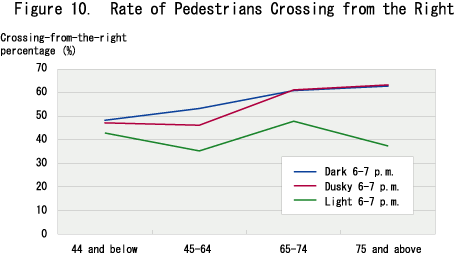
|
|
Why does the ratio of crossing from the right of drivers (among those involved in accidents) increase as the light level declines and among older pedestrians? The reason is thought to be as follows.
As Figure 11 shows, when a pedestrian wants to cross the road, he/she assesses the distance (speed) of an approaching vehicle and speed (distance) of walking, and then decides whether to cross or wait. If the vehicle is approaching from the left side of the pedestrian (in other words, the pedestrian is crossing from the right side of the driver), the pedestrian has to walk longer and is further from the vehicle than when the vehicle is coming from the right (as indicated in the right half of the figure), which can cause misjudgment. Other factors may be that seniors are often unaware that their speed of walking has slowed down, and that judging the distance and speed of an approaching vehicle becomes more difficult as the light grows dim. In some cases, pedestrian victims appear to have felt relieved when cars coming from the right have passed, but failed to check safety on the left side.
|
|
|

|
|
In summary, senior pedestrians apparently see things around them in the dusk just as they do in the dark: i.e. they can't see well in either light level. The primary problem of traffic in the dusk is the mixed presence of senior pedestrians with sight problems in the twilight and of younger drivers who believe it is still light enough.
c. Increase in Pedestrian Traffic Violations in the Dusk and at Night
Figure 12 shows the ratio of pedestrian violations, if any, by age group. The ratio declines as it gets dark in pedestrians aged 44 and below, who show no tendency to violate traffic laws more frequently when it is dark.
Among pedestrians aged 45 and above,the ratio of pedestrian violations increases as the level of light falls, with the ratio being about the same for "dusky 6-7 p.m." and "dark 6-7 p.m." The tendency is more pronounced in older age groups.
|
|
|
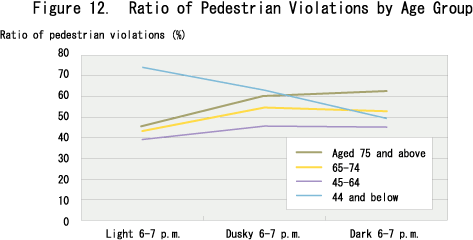
|
|
What types of violations are committed frequently? Figure 13 shows component ratios of violations by light level and by age group. Violations composing less than 10% are included within "Other violations".
Pedestrian violations that occur more often during "dusky 6-7 p.m." than during "dark 6-7 p.m." are "crossing immediately before or after moving vehicles" for senior pedestrians aged 75 and above, and "crossing at places other than a crosswalk" for those aged 65-74.
|
|
|
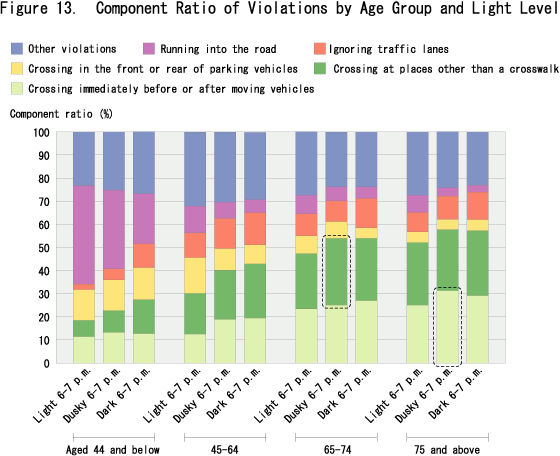
|
|
As Figure 14 shows, fatality rates of these two violations are significantly high. Senior pedestrians tend to jaywalk in such manners, especially in the dusk.
|
|
|
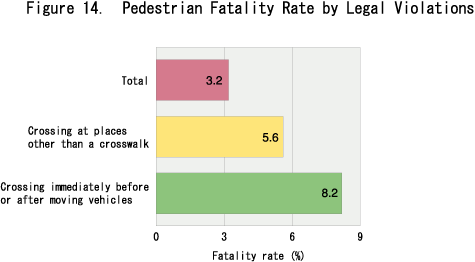
|
|
The reasons why aged pedestrians take such risks seem to be that, as discussed in the preceding sections, they cannot judge distances correctly, and cannot walk as fast as they think they can.
Running into the road is an offense that is less related to the decline of light level, and is mostly committed by relatively young people and requires no further discussion here.
|
|
|
UP
Back Next
|
